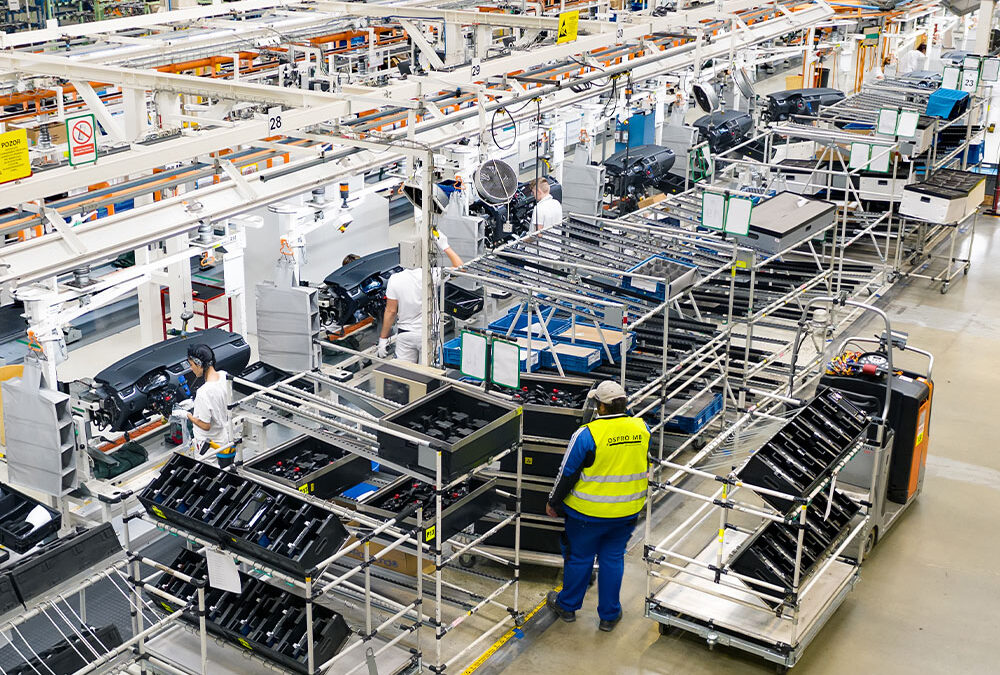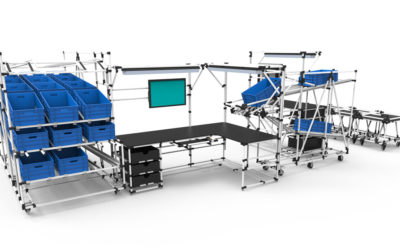Across industries and applications, material flow is a critical driver of facility productivity. How efficiently components move from one stage of your process to the next directly impacts operational costs, cycle times, and throughput. As more companies prioritize continuous improvement and lean manufacturing principles, industrial tuggers are emerging as a safer, more efficient, and cost-effective alternative to traditional forklifts. By enabling predictable, controlled material movement, tuggers help eliminate common bottlenecks and reduce operational risks—delivering measurable gains in productivity and performance.
What Are Industrial Tuggers?
Industrial tuggers are material handling vehicles designed to tow carts across a facility floor. Unlike forklifts, which lift and carry single loads, tuggers pull multiple carts connected in sequence, known as a tugger train. Their primary purpose is to facilitate efficient, repeated transport of materials—whether raw components, work-in-progress, or finished goods—between various areas of your facility.
Tuggers support lean material flow strategies by allowing just-in-time (JIT) deliveries, reducing unnecessary inventory buildup, and minimizing manual material handling. By enabling a consistent and predictable flow of materials, industrial tuggers help facilities improve efficiency and safety while optimizing floor space.
Exploring the Types of Industrial Tuggers
Industrial tuggers come in a range of types and configurations, each suited for specific applications and material flow needs. Choosing the right industrial tugger depends on factors like load capacity, distance traveled, facility layout, and process requirements.
#1. Manual Tuggers
Manual tuggers rely on human force to push or pull carts along designated paths. While limited in capacity, they are ideal for light loads, short distances, or in facilities where automation is unnecessary. Manual tuggers work well in assembly lines, kitting stations, or small production cells.
Best for:
- Lightweight materials
- Short-distance moves
- Low-volume operations
#2. Electric Tuggers
Electric tuggers provide powered assistance, allowing operators to tow heavier loads with minimal physical effort. Battery-powered and highly maneuverable, electric tuggers increase operator safety and reduce fatigue, making them a popular choice in larger manufacturing facilities.
Best for:
- Medium to heavy loads
- Repetitive material handling tasks
- Ergonomic improvements
#3. Automated Guided Vehicle (AGV) Tuggers
AGV tuggers operate autonomously using programmed routes and sensors for navigation. These systems remove the need for dedicated operators, offering a scalable solution for high-volume material handling with minimal human intervention. AGV tuggers are a key component of Industry 4.0 and smart factory initiatives.
Best for:
- High-volume production
- 24/7 operations
- Facilities investing in automation
#4. Tow Tractors
Tow tractors are heavy-duty industrial vehicles capable of pulling multiple carts or large payloads. Common in warehouses, distribution centers, and manufacturing plants, tow tractors are suited for high-capacity material movement across longer distances.
Best for:
- Large production floors
- Long-distance hauls
- Heavy or bulky material movement
Understanding How Industrial Tuggers Work
At the core of an industrial tugger system is the tugger train concept—a series of carts connected in sequence and pulled by the tugger along a predetermined route. These routes are typically looped through production lines, assembly or storage areas, and shipping zones, creating a continuous flow of materials.
Here’s how a typical tugger operation works:
- Loading: Operators load materials onto the carts at a centralized area in your facility.
- Transport: The industrial tugger hauls the cart train along a defined pathway, stopping at designated workstations for drop-off or pick-up.
- Unloading: At each stop, materials are transferred directly to production or assembly points without excessive handling or delays.
- Return Loop: The empty carts return to the loading point for the next cycle.
Ultimately, tuggers enable predictable material movement with scheduled runs, reducing wait times and keeping production lines properly supplied. This repeatable process increases production capacity, lowers labor costs, and supports lean manufacturing strategies.
Customization Options for Cart Trains Used with Industrial Tuggers
While ready-to-order cart train systems work well for many facilities, material flow challenges often require a tailored approach. Custom cart systems offer significant advantages when standard solutions fall short.
When to Consider a Custom Solution
But when exactly is a personalized cart train system worth the investment? Weigh these factors:
- Complex facility layouts or narrow aisles
- Unique material and/or varied container sizes, weights, or shapes
- Need for integration with existing equipment or automation systems
- Multiple department and process steps with different delivery needs
How Geolean Builds Unique Solutions
Geolean specializes in custom-engineered industrial carts designed to support your unique tugging application. With Geolean’s expertise, you gain a solution that fits your process—not the other way around, ensuring the equipment you purchase is aligned with a total program ROI. Our expert engineering team partners with your facility to:
- Assess your material flow requirements
- Design custom cart trains using high-quality components
- Ensure ergonomic, safe, and efficient operation
- Provide implementation support and lean material flow recommendations
Tugger vs. Forklift: Which Solution is Superior?
Many facility managers considering material handling upgrades face the classic question: Should we stick with forklifts or transition to industrial tuggers?
While forklifts served their purpose for many years, industrial tuggers provide today’s workplaces a safer, more efficient, and cost-effective alternative—especially for repetitive material flow tasks.
Comparison Chart: Tugger vs. Forklift
|
Criteria |
Industrial Tuggers |
Forklifts |
|
Safety |
Reduced accident risk, pedestrian-friendly |
Higher risk of tip-overs and collisions |
|
Efficiency |
Moves multiple loads in a single trip |
Moves one load at a time |
|
Cost-effectiveness |
Lower labor and maintenance costs |
Higher fuel, maintenance, and labor costs |
|
Floor Space Usage |
Narrow pathways, optimized layouts |
Requires wide aisles and turning radius |
|
Ease of Use |
Simple operation, less training required |
Operator certification and training required |
Transitioning from Forklifts to Industrial Tuggers
The shift to tuggers often results in significant improvements in floor space utilization, reduced wear on facility floors, fewer safety incidents, and lower operating costs. When you’re ready to implement industrial tuggers, our experts recommend you take these steps:
- Start small by identifying repetitive routes or non-value-added forklift tasks
- Pilot a tugger system on select lines or processes
- Train operators on industrial tugger operation and safety
- Track results to validate safety, productivity, and cost improvements
You don’t have to navigate the transition alone. Geolean has extensive experience guiding facilities through every step of this process—from assessing your current material flow and identifying improvement opportunities to designing the right tugger system for your operations. Our team also provides hands-on training to ensure your operators are confident and safe using the new equipment. We can offer ongoing consultation to support your continuous improvement.
Transform Your Facility Floor with Industrial Tuggers and Cart Trains
Whether you’re interested in ready-to-order cart systems or need a custom-engineered set of tugger carts, Geolean has the expertise to help you optimize your facility floor for lean operations. Our team of experts works alongside you to understand your process, design the right system, and provide implementation support to ensure long-term success. Ready to enhance your material handling systems? Contact Geolean to get started.



